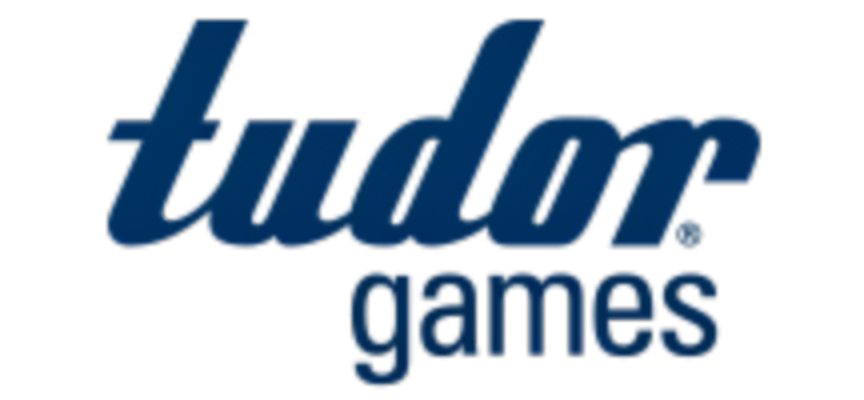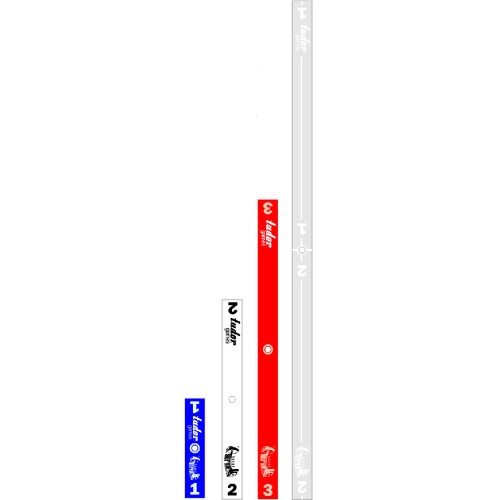Passing Sticks Set
-
$19.95
Our Passing Sticks are a 5 piece set made of tough acrylic and have a magnetic ball marker with a clear handle. Works on any size playing field!
The passing stick method is fully compatible with existing Tudor Games Electric Football rules and offers an alternate way to execute the passing game in Electric Football. This method can be used alongside or in lieu of the TTQB (Triple Threat Quarterback) passing method as you see fit.
The Tudor Games Passing Stick method offers a different experience from using the TTQB when executing the passing game in Electric Football. The ability of the defense to react to the ball while "in the air" is one of the main distinctions you'll note when using the passing stick method. Interceptions and pass interference are also noticeably different. While it is true that the challenge of 'hitting' the receiver with the TTQB thrown football is not part of this method, accurately reading defenses, avoiding interceptions and completing passes are no less challenging with 'the sticks' as you'll soon see. So read the rules below and enjoy incorporating the Tudor Games Passing Stick method into your next game.
Many of you may already be familiar with the Passing Stick method. It is quite popular and has been in use for quite some time. However, the Tudor Games Passing sticks differ a bit from those you may have seen in the past. Why? Well, rather than being based on any one field size or scale, the Tudor Games sticks are designed around one of the constants in the game of Electric Football-base lengths. Regardless of the field size you may play on, from small vintage boards to the Ultimate Tudor boards or any boards in between, all use generally the same size bases and figures. The standard length of these bases then has become the basis by which the Tudor Games passing sticks were designed upon.
Click to Download Passing Sticks Instructions
- Availability: In Stock
IDENTIFYING THE COMPONENTS
1. THE MEASURING STICK
The longest stick in the set is the long clear stick. This is known as the "Measuring Stick". You'll notice immediately that aside from being clear, it also has markings-most noticeably a centerline-that all aid in measuring the length of the pass being thrown. It is visibly split into two halves. One half bears the number 1 and the other half bears the number 2. The number one half marks the "Short Pass" zone and the number two half marks the "Medium Pass" zone. This stick is 10 base lengths long and is used to measure the distance between the QB and the Intended Receiver which is outlined in more detail below.
2. THE MAGNETIC BALL MARKER
The Magnetic Ball Marker (or MBM for short) is the round brown marker. The MBM is the same color as a football because it both denotes the pass target point and the football itself. Note that this marker has a magnetic bottom. This is to minimize its movement on metal boards when the power button on the PlayAction™ Remote is pressed.
3. THE THREE STICK
The stick bearing the number 3 is colored red. It is called "The Three Stick" or commonly "The Red Stick". This is used for "Long Pass" throws. This stick is six base lengths long.
4. THE TWO STICK
The stick bearing the number 2 is colored white. It is called "The Two Stick" or commonly "The White Stick". This is used for "Medium Pass" throws. This stick is four base lengths long.
5. THE ONE STICK
The stick bearing the number 1 is colored blue and is the shortest stick. It is called "The One Stick" or commonly "The Blue Stick". This is used for "Short Pass" throws. This stick is two base lengths long.
RULES OF PLAY
Start the play by pressing the PlayAction™ Remote and watch to see if an unblocked eligible receiver breaks open. If he does, and before a defender touches your quarterback, release the power button to stop the play, call "PASS," and identify the INTENDED RECEIVER.
TO PASS
Take the Clear Measuring Stick and hold it over the field so that the end of the "Number 1" side is above the helmet of the QB figure and the centerline also passes over the Intended Receiver's helmet. The stick is clear so you can get a good 'top-down' view of this. If the receiver is in Zone 1 this is a "Short Pass". If the receiver is in Zone 2 this is a "Medium Pass". If the receiver is beyond the measuring stick, this is a "Long Pass".
Once measurement has been completed and the length of the pass has been determined, the Intended Receiver and any other unblocked offensive player may be pivoted. Once this is accomplished the appropriate color stick is then placed on the field so that one end of the stick is touching the front base edge of the Intended Receiver (Note: The stick need not be flush with the front base edge, it must merely touch it and may be angled as desired).
If a Short Pass is being thrown, the Blue, Number 1 stick will be placed.
If a Medium Pass is being thrown, the White, Number 2 stick will be placed.
If a Long Pass is being thrown, the Red, Number 3 stick will be placed.
The Magnetic Ball Marker (the Brown Circular piece) will also be placed on the field at the other end of the stick being used. This represents the spot the QB is throwing the ball to and where (hopefully!) the receiver will be running his route to. Once the Magnetic Ball Marker has been placed, the stick is removed from the field.
The Defense may now apply PASS DEFENSE appropriately.
PASS RESOLUTION
The offensive coach presses the power switch on the PlayAction™ Remote until one of three possibilities has occurred at which point the coach releases the power button to stop and removes the Magnetic Ball Marker (MBM) from the field.
1. Any player contacts the MBM. Player contact is made when any portion of his base or figure touches the MBM.
2. The Intended Receiver has moved entirely past the MBM. The intended Receiver has moved past the MBM when the entire figure and base have moved past the MBM.
3. The Intended Receiver has turned away from the MBM. The Intended Receiver is deemed to have turned away from the MBM when it is clear that he is not moving in a fashion that will bring him into contact with the MBM nor carry him past the MBM.
PASS COMPLETION
If the Intended Receiver is the first player to contact the MBM, congratulations, the pass is completed! Following the completion, the offensive coach may pivot the receiver unless he was tackled as he made the catch. Otherwise the defense is then allowed to pivot any unblocked players toward the receiver. If the receiver is not tackled at the time he catches the ball, the defensive coach presses the power switch on the PlayAction™ Remote until the receiver is tackled, turns around, runs out of bounds, fumbles or scores.
If an unintended offensive eligible receiver is the first player to reach the MBM, the pass is still completed, but the receiver is down at the spot of the catch. No Yards After Catch can be gained.
ILLEGAL TOUCHING
If an ineligible receiver is the first player to reach the MBM, the play is dead and an Illegal Touch penalty is assessed. If the ineligible receiver was originally ineligible (e.g. an offensive lineman) this penalty is 5 yards from the previous spot. If the ineligible receiver was an originally eligible receiver that prior to the catch went out of bounds and then came back in bounds, the penalty is loss of down at the previous spot.
INCOMPLETE PASS
A pass can fall incomplete in two ways. The most common is that the Intended Receiver has moved past or turned away from the MBM. If no player touches the MBM prior to either of these events, the ball falls incomplete. The other way a pass falls incomplete is if any player OTHER than the Intended Receiver touches the MBM and is in contact with an opposing player. In these cases, it is assumed the pass has simply been 'batted down' and is therefore incomplete.
INTERCEPTION
If any unblocked defensive player is the first player to reach the MBM prior to the ball falling incomplete, that player has intercepted the pass! This defender may be pivoted to advance the ball and all unblocked offensive and defensive players may be pivoted to block or tackle. The offensive coach presses the power button on the PlayAction™ Remote until the RUNNER is tackled, turns around, runs out of bounds, fumbles, or scores.
PASS INTERFERENCE
One of the distinctions you'll see when using the Tudor Games Passing Stick method instead of the TTQB is the Pass Interference penalty becomes a more significant part of the game. Here are the rules for how this penalty is handled.
If the Intended Receiver, while moving towards the MBM for the catch, is contacted by an opposing player at some distance outside of a base length from the MBM, a Pass Interference penalty has occurred against the defense. In the NFL, this penalty is 1st down for the offense at the spot of the foul. If the interference occurred behind the defensive goal line, it is first down for the offense on the defense's one-yard line, or, if the previous spot was inside the two-yard line, halfway between the previous spot and the goal line.
If a defensive player, while moving towards the MBM for the interception, is contacted by an opposing player other than the Intended Receiver at some distance outside of a base length from the MBM a Pass Interference penalty has occurred against the offense. The penalty is loss of 10 yards from the previous spot.
Any contact made at some distance within a base length from the MBM is considered incidental and no penalty is assessed.






